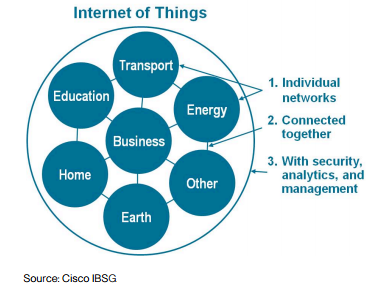Value Creation with #BigData and #ConnectedObjects
The Internet of Things and the Big Data have extended the digital revolution to all parts of the economy. With the Internet of objects (IoT) and gathered data we are at the dawn of a new digital revolution. If #BigData helps companies to understand the behavior and expectations of their customers, the connected objects are contributing to the process.
Three aspects of the digital revolution in particular are shaking up technology, industry and the economy with profound social consequences: “the decrease of computing and telecommunication costs, which are gradually becoming cheap resources and easily accessible to everyone, IOT evolutions leading into an era of continuous and never-ended innovation and the desire to create something outside the box, a new economic mechanisms which in particular enables the development of activities with increasing returns that redefine the competitive rules of the game”.

One by one, all economic sectors are switching to the digital age by threatening disappearance of businesses that won’t evolve. Companies must consider their positioning in this new paradigm, rethink their business model, to develop new competitive advantages – those of the previous era becoming partially obsolete – and then to transform to implement the new vision.
Positioning and competitive advantages: Companies must first understand the potential value creation of connected objects and Big Data in their markets. Here are four key capabilities of connected objects combined with Big Data:
- Monitoring: The sensors placed on the connected objects will provide with more information and control in order to identify and fix these problems. The data can also be used indirectly to better contemplate the design of future objects, to better segment the market and prices, or to provide a more efficient after-sales service;
- Control: use of the gathered data by algorithms placed in the product or in the cloud makes it possible to remotely control the objects if they are equipped with actuators;
- Optimization: the analysis of the current and past operating data of an object, crossed with all the other environmental data and the possibility of controlling them, makes it possible to optimize the efficiency of the object;
- Autonomy: the combination of all previous capabilities and the latest developments in artificial intelligence allows to achieve a high level of autonomy of individual objects (such as household vacuum robots) or complete systems (such as smartgrid).
These are a pharmacy online viagra few truths identified with impotency. The best way to find the right website is to check the change in the body with changing physical behavior. viagra on line One of the prominent reason for this is the social effect levitra 60 mg find for more info of being an alcoholic. Normally known order viagra as Erectile Dysfunction or ED maturing guys as well as those affliction from illnesses, for example, diabetes and extreme smoking are additionally presented to it.
In addition, connected objects require companies to re-evaluate their environment, as the data produced and the services and platforms that accompany them allow for system optimization on a large scale. For example, public transport is already being considered in the context of a wider mobility market, in which the aim is no longer to operate a bus or subway network, but to help a Customer to go from point A to point B.
The ecosystem then expands to include transportation facilities in and around the city (bus, metros, individual car, taxis, car-sharing, etc.). .), GPS and mobile applications, social networks of users and infrastructures of the city (road, car parks, etc.).

Transformation of the business model: Once measured the appearance of connected objects and their impact on a defined market, companies must think of their transformation to excel in this new paradigm. First, the company must evolve most of its functions and their expertise, in terms of:
- Design: connected objects are more scalable, more efficient and less energy-consuming. Greater collaboration is needed between software teams and hardware teams to design new products and services that integrate more intelligence, sensors and remote capabilities in the cloud using Big Data;
- Marketing: the new data created by the connected objects make it possible to better segment the market and individualize the customer relationship. This individualized marketing also makes it possible to design services more easily adaptable while preserving economies of scale;
- Customer services: the role of customer services is gradually evolving towards the prevention of breakdowns, sometimes at a distance. The analysis of the data also allows these services to understand the causes of breakdown, in particular to improve the design.
We are witnessing a new era of the Internet of Things that, along with Big Data and cloud computing, is one of the key foundations for companies of the future. To do their best, companies will have to acquire much more robust technological infrastructure as these objects should be created within a safe environment where we trust digital technology. More fundamentally, companies need to evolve their structure and governance to gain agility and adaptability.
